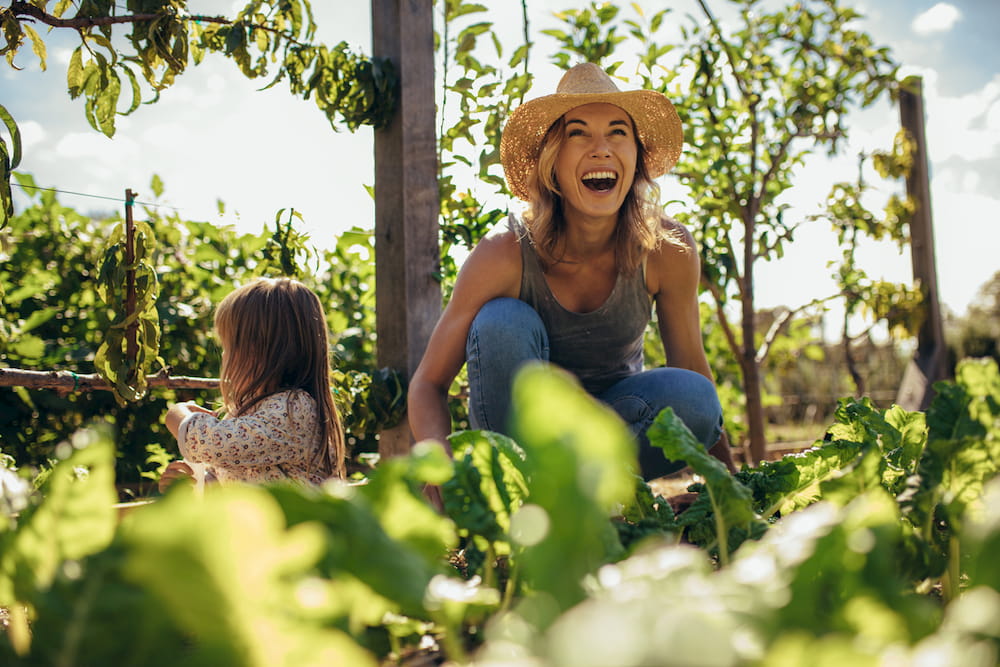5 Reasons To Plant Your Own Garden
The first summer we lived in our new home, we planted a small single raised bed with zucchini, arugula, spinach, kale, and radishes. I knew it wasn’t going to be easy since I had absolutely no idea how to start or keep a garden going; not to mention I have a hard time keeping my indoor plants alive. That summer, we yielded ONE zucchini. Yes, just one single zucchini. I sat it atop my kitchen windowsill like a trophy, hesitant to even eat it. From then on, I knew I needed to learn a bit more about how to take care of and grow a garden. In my defense, I was pregnant, and we were new homeowners. So maybe it wasn’t the best time to start a new venture.
Nonetheless, after gathering our tools, building raised beds, reading up on gardens in general, and fencing it in to keep all our woodland friends from eating our crops, we set out to plant a garden this spring and give it some TLC.
I can’t believe I’m saying it. This year, our garden is overflowing with green goodies! We have an abundance of kale, arugula, radishes, lettuce, and most recently spinach and swiss chard. After years of dreaming of a raised bed garden that I can enjoy with my two little daughters, this summer we have one. And I am so excited about it.
There are so many reasons you may want to consider planting a garden of your own. I’ll share my top 5 to give you some inspiration to start your own. Whether it’s a container garden, apartment scattered with plants in pots or field of full of bountiful food, gardens are a great way – small or large – to make a positive impact on your health and your environment.
1. Food is Fresher
When you plant your own garden, the food is as fresh as it gets! Each afternoon we go out to the garden to pick out a fresh harvest of kale and arugula for lunch salads. It doesn’t get more farm-to-table than that. You can literally taste the difference in the quality of the produce – high in vitamins and minerals because it doesn’t have to sit on a truck or on a grocery store shelf waiting for you to pluck it from the bunch. You control the environment that the food is grown in – avoiding pesticides and chemicals, choosing the soil, and the compost. It moves from dirt to mouth in a shorter time span, giving you a better quality, most nutrient-dense version of your favorite garden goodies.
2. Pick Your Favorites
Planting your own garden means you can pick out whatever you want to plant, whatever you and/or your family will consume most, whatever veggies are your favorite. We happen to eat a lot of salads here, so we thought we would plant a bunch of greens and see how they took this summer. Next year, we may add tomatoes, squash and zucchini. But for this year, we knew we would eat the spinach, kale, arugula, and swiss chard the most. They are our favorite! So instead of getting them at the farmer’s market or the store, we now have our own supply, or should I say surplus right in the backyard.
3. Family Friendly
Gardening is a great way to spend time with your kids, partner or other family members outside. Maybe even your dog. For us, it has been the perfect way to spend our weekends, tending to the garden, harvesting and cleaning kale, pickling radishes and teaching our daughters about how food is grown and where it comes from. Involving them in the process has been so rewarding for all of us. My oldest daughter loves picking out her own kale, helping us wash and dry it and participating in making her own salad. It encourages children to want to eat more fruits and veggies when they are involved in the planting and picking process themselves.
4. Best Bang for Your Buck
Depending on what kind of garden you build and plant, your initial investment will more than likely pay for itself. It is much more cost-effective to tend to your own garden and harvest your own produce than it is to spend money on gas to get to the grocery store, spend time and money picking out your produce at the market. A single packet of seeds can yield an entire season worth of your favorite food for your family. For us, that happens to be kale because of its versatility and longevity in the later fall/early winter season.
5. Seasonal + Sustainable
Our health is best supported when we eat locally and seasonally to our region and environment. In the Northeast, gardens are a great resource from late spring to late fall. The foods that grow in each season do best because of their climate – the humidity, soil health, temperature, rain, and sun. In the spring we see lots of fresh detoxing foods like radishes and arugula. In the summertime, we see zucchini, tomatoes, cucumbers – foods that are very hydrating during the hot months. In the fall, we harvest a bounty of root vegetables and dark leafy greens, foods that boost our immune system for the winter ahead. When we choose to eat seasonally, we are reaping the reward of the region’s richest produce, when it is freshest and most nutrient-dense, local to our own environment. When you grow your own garden, you have direct access to crops that flourish from season to season. Even on a small scale, the garden itself is sustainable and supports the environment because you are using less plastic at the grocery store, less gas to get there and back, and spending fewer dollars that support farms in other countries and other states, paid for when your purchase that produce.
Gardens can be a lot of work but they can also be a great way to get your hands dirty, boost your immune system with healthy gut bacteria, spend time with your children, save money, learn a new skill, and live off your own land.
If you don’t have an abundance of space or a big backyard, try starting with an indoor or windowsill garden – planting your favorite herbs for garnishes on salads and your favorite dishes. Or consider trying your hand at growing microgreens – teeny tiny nutrient-potent greens that are great on their own, atop salads, or stuffed into sandwiches. Happy gardening!
More Articles You Might Like










Doctors’ orders have been to eat vegetables every night for as long as we can remember, right? So don’t stop now. These five vegetables deserve a spot on your plate for more reasons than one.